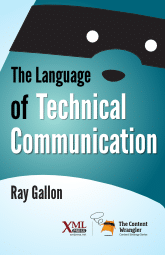
XML Press published Ray’s book, The Language of Technical Communication, a few months ago, and he’s been featuring a new term each week on the book’s site. Today, metadata is the term of the week! Take a look to see how metadata can help your technical communication efforts.
Why you should care about metadata
Quick insight: Metadata is the information about content that helps software make content even more powerful. Think about facets like the dates related to content, author, source, topics, and lots more information that you can use to structure your content work within a software framework. You can use metadata to write rules to extend the power of your content automatically.
If you haven’t seen the inner workings of a content management system before, you may not realize it, but it’s pretty easy to publish content without ever thinking about the structure of the content. You can ignore how the content relates to other content or topics. And you can place your content manually. And you may not realize it, but that is awful!
When we use computers to design experiences — websites or apps — we need to take full advantage of the efficiencies available with today’s sophisticated software. And that means thinking about how our content works together as a part of the experience. Metadata makes that possible. When we define the facets and categories and information related to our content, we can use that information to make content management and content publishing far easier.
Check out my essay on metadata, or get Ray Gallon’s book on technical communication today.